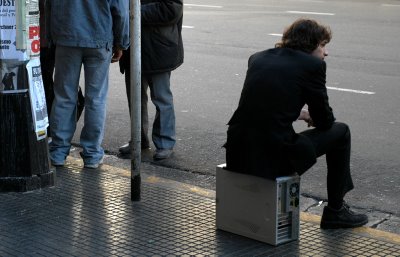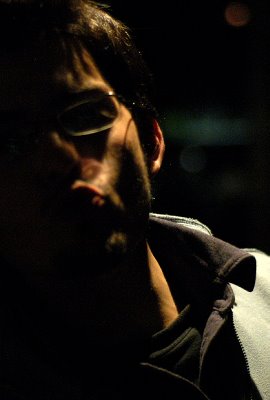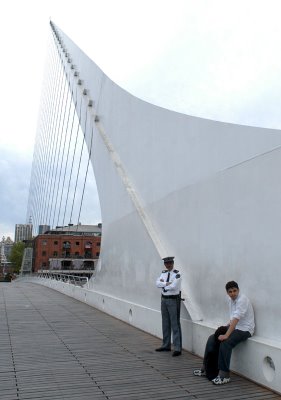I loved the Argentinean people. They were vibrant, beautiful, full of life, and awfully creative. See? They finally found a good use for the PC tower! (I'm an Apple user, for all of you who don't know)

After I finished touring the photographic exhibits at the end of Florida Street, I found myself at the crux of a daunting situation in a foreign country. Tengo hambre. I'm hungry.
My (sort of useless) Spanish phrase book (because Argentineans don't speak Castilian Spanish) in hand, I walked down the stairs to the basement of the building where there was a food court selling everything from steaks and sandwiches to Chinese food. There is nothing as interesting to a traveler as the food he or she encounters. It is one of the first things people ask me about Argentina or Korea.
Lunch was to be my first meal in Argentina. I wondered if the plump, pimply girl behind the cash register felt any pressure as I haphazardly ordered a submarine sandwich filled with something called "Lomo" that wasn't in my Castilian phrase book. Was she worried about how I might react to Argentinean food? She had me pinned as a Shankee from the second I opened my mouth.
"Olah, me gustaria, uh, uhhhhhh, pee-dir lo-mo, uh..." I stumbled.
She smiled patiently and finished my sentence for me in perfect English.
"..Italiano. Do you want fries and a cola?" Sure. Boy, that was too easy. Korea was so much more fun.
Wait, back up. Shankee? What's a Shankee?
"Shankee" is the word Argentinean people pin to ignorant American jackasses like me. Actually, it is little more than the word "Yankee" pronounced in the Argentinean Spanish accent, which slides Y's and LL's into an "Sh" sound. "Llamo" sounds like "shamo," "yo" sounds like "sho," and "Yankee" sounds like "Shankee." I resent that nickname. I'm a Boston fan!
After a long wait, I got my lomo submarine. Lomo is nothing more than beef tenderloin, and it goes well on French bread with mayo and tomatoes. They served me a coke with no ice and a plate of salty, rubbery fries. Typical mall food court fare, I thought as I mindlessly consumed the mastication-resistant fries. I rode the sugar buzz all the way home, where my blood glucose levels crashed and I fell into a fast-food fostered sleep on Faith and Bernardo's mafia-made couch.
Mafia-made couch? I guess I didn't mention that the mafia runs Argentina, or so it seems. A day didn't go by that someone didn't mention the mafia and/or how they are closely related to the government, a sort of Argentinean Department of Nefarious Deeds. People said, and I believed them, that they were closely tied to the police through bribes and blackmail.

All sort of inconveniences, infrastructure problems, monetary issues and even the couch I was sleeping on were the result of some super secret anarchic ultracapitalist subculture existing just under the surface of a seemingly lawful society. Sounded like home to me.
Oh, and the couch. It had, uh, character.
Faith and Bernardo, who recognized the awful state of their couch, insisted I sleep on a spare mattress, which was a million times more comfortable than the lumpy brown couch. Actually, I hadn't complained about the couch. After six month on the Appalachian Trail, I can sleep in any weather, anywhere, on anything, and if it just happens to be soft, well! The couch was soft. Lumpy, yes, but soft. I slept well on both couch and mattress.
The story about the couch went like this. Faith and Bernardo went to a futon store, found a mattress they liked, and asked for it to be delivered. Upon delivery, not a solid Japanese futon but a loose brown corduroy bag filled with shredded foam was heaved into their apartment along with the convertible bed/couch frame that came with it. My friends complained and demanded the correct mattress be delivered pronto, but it all came to naught, and they knew who was to blame.
The Mafia! (cue dastardly music/evil laughter).

As you can tell, I took the whole matter much too lightly. People made it sound like the mafia was this omnipotent force, everpresent, never sleeping, waiting behind every tree to leap out and nab your purse. Luckily, I don't carry a purse.
People would point out something backwards or ridiculous about Buenos Aires, speculate in the form of a question as to the nefarious rationale behind the seemingly irrational phenomena indicated, and then let the obvious answer hang in the air like a fart. Mafia. Had to be. Bastards. I found it all amusing, and tried to encourage Faith and Bernardo to see it the same way. They didn't, and with good reason.
In December of 2004 a fire ripped through the Cromagnon night club where hundreds of people had gathered to hear the rock group, Los Callejeros. Someone had wired the doors shut to prevent people who hadn't paid from entering the concert, and 194 people died in the resulting fire trap, including several small children. Fingers were pointed, the owner was arrested, and investigations were dutifully conducted.
The investigations found the government's fire inspection unit badly managed and corrupt, the fire department and emergency response teams underequiped and poorly trained, and the owner of Cromagnon to be unreasonably oblivious to the obvious fire hazards in his club. The mayor lost his job over the matter, but it was small consolation to the residents of Buenos Aires, who all knew who was really behind the disaster. Mafia.
Monday night Faith and Bernardo took me to club called The Konex to hear a percussion group called "Time Bomb" do their thing. I hadn't yet heard about Cromagnon at this time. Bernardo's college friend Martin drove Faith, Bernardo, and another friend, Diana, to The Konex along with me in his old blue Renault stick shift.
This is a picture of Martin, who everyone calls by his nickname, Tincho. He graduated from film school with Bernardo, and uses his tremendous talent to a number of artist ends. He is a virtuosic painter and his films exhibit a masterful command of timing, light, and photography.

And this is Diana, a lovely entrepreneur from the same neighborhood Faith and Bernardo live in. During the economic crisis in the late 1990s, she lost her job working as a designer with an internet company, and started her own business helping independent designers of all breeds network and sell their products online. She is also an amazing photographer, who proved to me over the course of two weeks that it is the photographer who makes the image, not the camera. Don't worry, I'll explain later.

OK, where were we? Oh yes, the KONEX. This is also a reference to my previous thread on the mafia. Ah-hm.
Martin parked down the street from The KONEX, and I was the first one out of the car. A gruff, middle-aged man with a stocky build and a polypro windbreaker walked up to me and started speaking fast in Spanish. He had a serious look on his face, and I wondered if he was mafia. He certainly looked the part. The only words I understood were "car" and "to pay." Martin and Bernardo quickly took over for me, as the man was starting to get exasperated, as answer to his questions was a slow, "un momento. Habla despacio por favor." One minute. Please speak slower.
"Mafia," Faith said in a whisper as Bernardo and Martin dealt with the man. They had to pay him a small fee for his "protection" against thieves. A couple of pesos and no harm would come to Martin's car. How funny, I thought. A human parking meter!
All the money actually bought was protection from the man himself. When we returned to the car later on, he was gone. There was nothing in the car worth stealing, as someone had already ripped off Martin's stereo long ago, and Tincho had been shrewd enough not to replace it. An American living abroad (from my home city of Atlanta) named Sarah and her friend joined us.
The concert itself was a treat. We entered what had been a factory that had been converted into a cavernous music venue with giant red neon letters spelling the word KONEX laid out diagonally in front of the windows. It looked like a set from the first Batman movie. I would have photos, but Faith and Bernardo urged me not to take a camera, as it would result in a more personal meeting with members of the mafia.
The band, Time Bomb, was a collection of music students, focused mainly on percussion, headed by their charismatic professor. They practiced at The Konex, and then afterwards put their skill and talent to work for whoever could spare seven pesos (two bucks). It was an absolutely astounding show.
Ten to twelve musicians sat in a circle around their master, a dazzling array of percussion instruments laid out at their feet. As we walked into the room, they were working on a simple but catchy phrase with their drums. Their professor, the conductor, stood at the top of the circle with two small hand drums on stands by his side, his black wingtip shoes keeping time on the floor. He was a thick, jovial man dressed in dark clothing with thick black hair and a pirate-like mustache.
He swayed like a martial artist to the increasingly complex rhythm, watching and communicating with each musician with a series of homegrown, unique and delightful hand gestures customized to change the meter, instruments, styles or even which musicians were emphasized.
Over the course of three hours, the conductor and his students filled The KONEX with a thunderous, emotionally charged sound made from scratch. They brought in new instruments, different styles, mixed them in unbelievable ways and toyed with the sound like the wind plays with a falling leaf. Everyone was dancing, clapping and swaying to the sumptuous beat. Everything and everyone, down to the crowd itself, became an instrument in the hands of the conductor.
At one point, the conductor set the audience to clapping in time for him, and upon that human pulse he brought a symphonic masterpiece to life, sending the crowd into wild cheers. It is said that friendship is one soul in two bodies. By the time Time Bomb was through, everyone standing in the KONEX were friends. The cadence united us and released us as each melody changed, built and resolved itself over and over again. I realized how much color and creativity was to be found in Buenos Aires, and the whole night I pined for my camera. As we drove home, I ached to go explore.
Over the next two weeks, I got my wish.
The next day, Faith took me downtown, where she works as a mortgage saleswoman (another benefit of being bilingual), and knowing my love of the outdoors, pointed me towards the Parque y Zona de Reserva Ecologica Costanera Sur. This massive stretch of managed land spans dozens of city blocks, bordered by downtown Buenos Aires on the western flank and the Rio de La Plata to the east.
The route Faith chose took me down the long series of dikes that lined the main avenue downtown. In the first dike, sailboats rested.

The area by the dikes is another trendy location slowly being turned into a haven for tourists. Called Puerto Madero, it made for pleasant sightseeing. To my right were buildings housing upscale restaurants and pricey lofts. To my right was what looked like a train station converted into similar monuments to Western comforts and decadence. An artful bridge pictured on the cover of my city guide spanned the dikes. Called the Woman Bridge, it was designed by celebrated Spanish architect Santiago Calatrava Valls. Wes, these photos are all for you, my friend.



Rowers silently glided past me as I stopped at a small cafe for lunch. I had a lot more luck this time. I ordered a chicken sandwich on pita bread and a cup of espresso. Cost to me: $4, and Faith told me later I got ripped off.

At the end of the dikes, the road turned into the ecological preserve. In the turn of the century, it was a popular destination for bathers, and had docks along the ponds for such purposes. Nowadays you'd have to be absolutely bonkers to try swimming in the Rio de La Plata or any pond fed by its polluted, neglected waters. Unlike the Koreans, the Argentineans don't have a particularly close relationship to the sealife living side-by-side with them.
"Our backs are to the river," Bernardo pointed out about the city's design.
I walked a broad sand path towards the river, bikers, joggers and school children my companions. Behind me, the skyline of Buenos Aires rose above the razorgrass and pine trees.


People rested and took in the open space, a necessity in a city the size of Buenos Aires.

Others looked for a place to escape and be together.

At four thirty, I met Faith after work and followed her to her next job: Teaching English in the Palermo district. But you will have to wait till the next update for those stories and photos. Also, I'll get into the joy of using Spanish and Rashashana with Bernardo's family. Jeez, I'm only two days into my trip. Don't worry, there won't be 14 updates on Argentina, but these first few days really stand out. I guess that's true anywhere you go. It's all about travel. So till next time...Peace. --Notes
4 comments:
HEY. While I was struggling with this same work doing overtime you had good time there wandering feeling realizing thinking watching listening. Good for you and I really envy you. Pictures of this up date are also good. I really think you know the beauty of simplicity and good composition. You are an artistic photographer. So did you like the food there? Sounds like you have been to few places alone while your friends are working.
Place looks like two extremely different things are existing together. Which industry is that place focused on?
I can imagine how fun you had when you went to that percussion music club with your friends. That life style is what I exactly want! Now the only joy that I have in my life is listenning to the music by radio and read books. I wish I have some friends who can share the interest of music and stuff with me. Maybe I have to wait to get back with someone......
Hey I'm still working on the movie list. Don't expect too much though I'm not sure you would like the movies that I like.
How are the movies in Argentina? Some of South American countries are depending their film making on USA as far as I know. So I wonder how the Argentine movies are independent or different and what is their own character.
I'm looking forward to reading your next up date.
Good job, my boy.
Hey there, it's been a long time since I have seen or talked to you but I checked your blog many times and really enjoyed all the photos and comments. Keep blogging. You are awesome.
where´s the rest of the updates?
i agree with daimon
Post a Comment